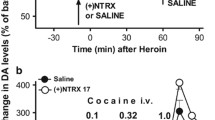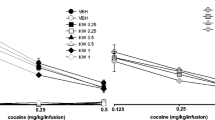Abstract
Rationale: Based on the differential distribution of dopamine (DA) D3 receptors in mesolimbic regions relative to nigrostriatal regions, the hypothesis was that D3-selective antagonists (i.e., higher affinity at D3- than D2-receptors) would be more potent than D2-selective antagonists at decreasing total cocaine intake relative to disrupting rates of responding. Objective: To evaluate the effects of acute administration of seven DA antagonists with varying affinities for D2 and D3 receptors in monkeys self-administering cocaine. Methods: Rhesus monkeys were trained to self-administer intravenous cocaine (0.01–0.3 mg/kg per injection) under a fixed-interval (FI) 5-min schedule during daily 4-h sessions. The use of a FI schedule allowed for independent assessment of rate effects and changes in reinforcement frequency as a consequence of drug pretreatments. The compounds examined, in order of D3 binding affinity, were: 2,3-dimethoxy-N-(9-p-fluorobenzyl)-azabicyclo[3.3.1]nonan-3β-yl benzamide (MABN) = eticlopride = 5-bromo- 2,3-dimethoxy-N-[1-(4-fluorobenzyl)piperidin-4-yl]benz-amide (BBP) > spiperone > fluoroclebopride (FCP) > 2,3-dimethoxy-N-(p-fluorobenzyl)piperdin-4-yl benzamide (MBP) > haloperidol. Results: In the absence of any pretreatments, cocaine-maintained responding varied as a function of dose and was characterized as an inverted U-shaped function, while cocaine intake increased in a dose-related fashion. When the dose of cocaine that maintained peak rates was available, all DA antagonists decreased response rates and cocaine intake in a dose- dependent manner. Increases in cocaine dose attenuated the effects of the DA antagonists, resulting in rightward shifts of the cocaine dose–response curves. Based on the ratio of behavioral potency at decreasing response rates relative to intake (ED50 rate/ED50 intake) when the highest cocaine dose was available, the order of potency and ED50 ratio values were: MABN (2.5) > eticlopride (1.63) > BBP = spiperone (1.5) > FCP (1.35) > MBP = haloperidol (0.89). This order parallels each compound’s affinity at D3 receptors (r 2=0.84) to a greater degree than D2 receptor affinity (r 2=0.34). Conclusions: These results, using a FI schedule of cocaine self-administration, suggest that D3 receptor antagonists are more likely to selectively decrease intake relative to response rates than D2 receptor antagonists.
Similar content being viewed by others
Author information
Authors and Affiliations
Additional information
Received: 8 January 1999 / Final version: 15 June 1999
Rights and permissions
About this article
Cite this article
Nader, M., Green, K., Luedtke, R. et al. The effects of benzamide analogues on cocaine self-administration in rhesus monkeys. Psychopharmacology 147, 143–152 (1999). https://doi.org/10.1007/s002130051154
Issue Date:
DOI: https://doi.org/10.1007/s002130051154




